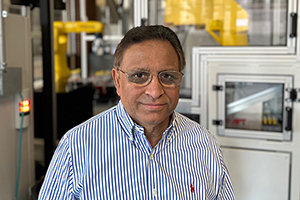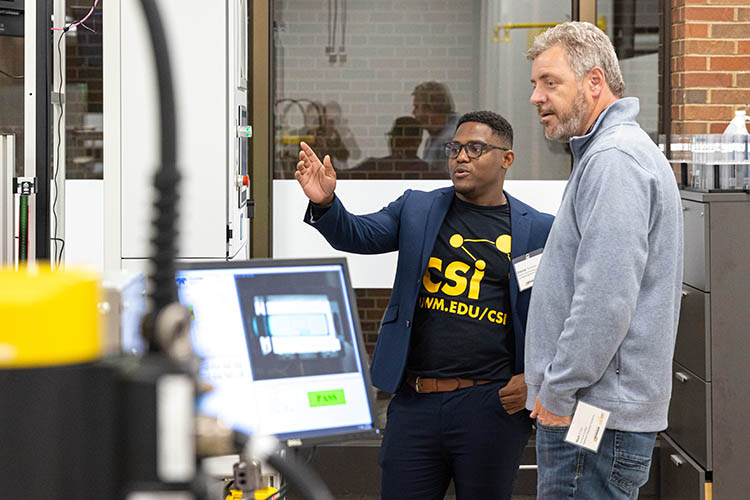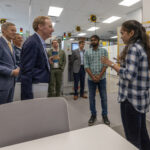The rise of smart technologies in manufacturing plants can be a little overwhelming for small and medium-sized operations who are less likely to integrate these into their businesses.
The Connected Systems Institute at the University of Wisconsin-Milwaukee has an answer: Researchers there created a tool that could help smaller companies ease into next-generation manufacturing. It’s a factory-specific GPT, or generative pretrained transformer, allowing workers to use natural language to interact with the production line and receive immediate answers.
Think of it as a virtual assistant, like Alexa, except for manufacturing.

“Small businesses cannot afford high down times,” said CSI Academic Director Atish Sinha, who is also the Rockwell Automation Endowed Professor in Connected Systems. “If a machine fails, you can troubleshoot and fix the problem as soon as possible using this tool. So, that is going to save the business a lot of time and money with a relatively small investment in AI.”
Launched in 2017, CSI provides opportunities for industry partners to work together with faculty and student researchers from UWM and collaborating universities to develop advanced manufacturing processes using the facility’s testbed production line.
The term connected systems refers to the use of artificial intelligence, streaming data on the Internet of Things (IoT) and automated robotics to improve factory efficiencies.
Support from Microsoft
Shamar Webster, a second-year graduate student in computer science, co-created the prototype tool with Microsoft’s chief AI officer, Balamurugan Balakreshnan, after getting the idea when ChatGPT was made public a year ago.
“I faced challenges transitioning to the manufacturing world,” Webster said, “especially in operating our industrial manufacturing testbed. I wanted a co-pilot for troubleshooting in manufacturing.”
The tool can be much more powerful than a traditional chatbot, Sinha said, because it will allow employees to engage in conversations about, for example, understanding the production line’s safety systems, performing quality checks and other institutional knowledge.
“One of the big advantages is that it’s going to address an employee skills gap,” he said. “Let’s say a new employee comes on board and he or she doesn’t have the expertise yet to understand what is going on in the manufacturing production line.”
Although the tool is being used on the CSI testbed now, it’s still early and will need some modifications before it can be programmed to act like a virtual assistant.
The CSI tool combines the capabilities of different technologies, including Microsoft’s Azure Machine Learning, which enables it to become AI-trained with information from the testbed’s operations and maintenance manuals.
Microsoft has lent significant support to the institute with two gifts – one in 2019 and the other announced Jan. 19 – totaling $2.7 million. Microsoft CEO Satya Nadella graduated from UWM’s College of Engineering & Applied Science in 1990 with a master’s degree in computer science.
“We at UWM are so grateful to Microsoft for their continued support of the Connected Systems Institute,” UWM Chancellor Mark Mone said. “Their gift allows us to expand innovation among Wisconsin manufacturers through the adoption of Industry 4.0 and AI technologies and to meet the ever-increasing demand for a highly skilled workforce. Together, we are advancing the economic growth of our region.”
Training and research come together
The testbed brings together numerous products developed by various companies that participate in the institute – plant and automation control tools from Rockwell Automation and Endress+Hauser; operational technology security systems from Fortinet; and industrial wired and wireless networking from Cisco. The CSI industrial datacenter includes hardware from Dell and cloud storage from Microsoft. Other industry partners include We Energies and the Wisconsin Economic Development Corporation.
That’s a lot of new technology available for research and development.
Another tool that CSI researchers and students designed is one that improves computer “vision,” aiding in object classification. Again, a problem from the testbed inspired the solution.
CSI’s testbed moves vials of colored water along a production line to fulfill orders. When automated robots were mishandling vials, Webster determined it was because some of the vials were damaged.
The robots on the testbed line can recognize the color fidelity of the recipe inside the vials, but they weren’t catching flaws in the vials themselves, he said.
The CSI team created and tested an automated system that includes a video camera that streams live data from the manufacturing line. He then layered on an AI model he trained with a dataset of 3,500 images that included those of translucent vials.
“This is a custom image recognition tool to detect anomalies in any kind of product,” Sinha said. “That would be of interest to smaller companies because it doesn’t cost a lot of money. All you need is a camera and an AI learning system.”
The real-time vision tool can make flaw detection with 90% confidence, reducing the need for human oversight.
CSI offers workshops in advanced manufacturing that smaller operations can take advantage of, Sinha said, and there’s interest in those.
“To convince them of the relative advantage that industrial IoT and open AI technologies provide, we have to monetize it,” he said.







